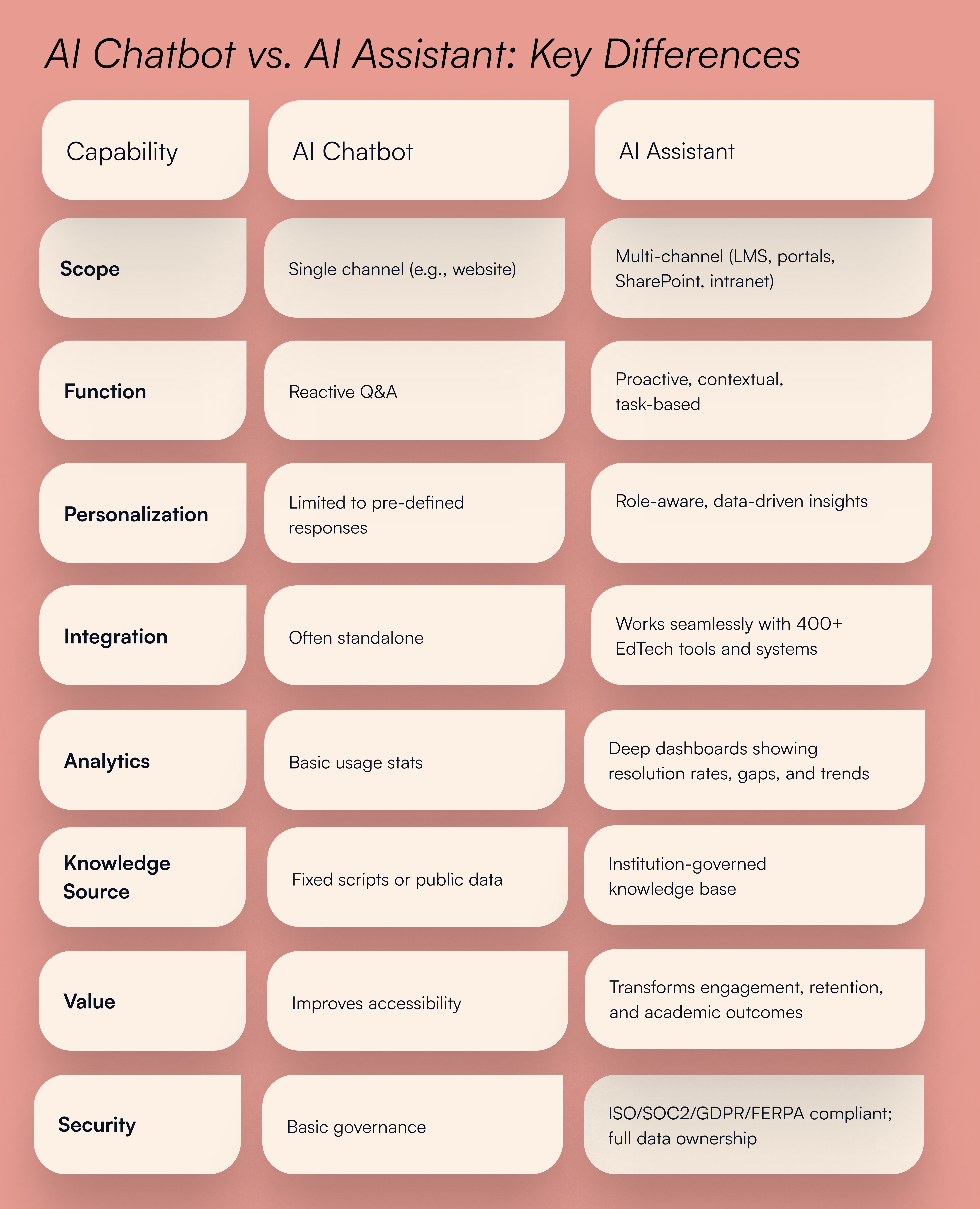AI Assistant vs. AI Chatbot: What’s the Difference in Higher Education?

AI Assistant vs. AI Chatbot: Why the Distinction Matters
In higher education, the term “AI chatbot” is everywhere. From enrollment to IT helpdesks, institutions are deploying conversational tools to handle routine student queries and improve service efficiency.
But as AI matures, a new category is emerging: the AI assistant. It’s designed not just to answer questions but to understand, support, and act across the entire student journey.
Understanding the difference between an AI chatbot and an AI assistant isn’t just a technical detail; it’s key to planning the next stage of digital transformation across campus.
What Is an AI Chatbot?
An AI chatbot is a conversational interface built to respond to questions using pre-programmed logic or simple machine learning. In higher education, chatbots are commonly used for:
- Answering FAQs about admissions, timetables, and financial aid
- Providing quick links to institutional resources
- Assisting with basic troubleshooting or campus navigation
Chatbots have helped universities and colleges save staff time and offer 24/7 support, especially during peak periods like enrollment.
However, chatbots are typically reactive: they respond to user input rather than anticipating needs. Their scope is usually limited to a single dataset or platform, and they often sit as stand-alone widgets, disconnected from the wider ecosystem of learning and student support tools.
What Is an AI Assistant?
An AI assistant, in contrast to an AI chatbot, operates as a proactive, integrated layer of intelligence across multiple systems.
Rather than being confined to one chat window or workflow, AI assistants can:
- Integrate seamlessly with your LMS, website, and SharePoint, meeting users where they already work and learn.
- Personalize responses based on user role (student, faculty, or staff).
- Analyze interaction data to surface trends and improve institutional knowledge.
In other words, an AI assistant doesn’t just respond: it learns, adapts, and acts. It becomes an active member of your digital campus ecosystem, enhancing both experience and efficiency.

While a chatbot supports transactions, an assistant supports transformation.
Why Institutions Are Moving Beyond Chatbots
Higher education leaders are recognizing that today’s students expect high personalization and instant digital support, but also want meaningful, human-centered learning experiences.
Chatbots deliver accessibility. AI assistants deliver continuity, personalization, and impact.
Modern institutions are now using AI assistants to:
- Deliver real-time academic feedback directly within the LMS.
- Provide tutoring-style support tailored to each learner’s progress.
- Identify and close content or knowledge gaps through analytics.
- Enable workflow automation that saves staff time and routes complex issues to the right department.
This shift represents a move from “just responding faster” to “understanding and acting smarter.”
How LearnWise AI Extends Beyond Chatbots
While many vendors stop at chatbot functionality, LearnWise AI supports a truly holistic approach to student and staff engagement, one built around integration, governance, and actionable insight.
Beyond simple chat, LearnWise AI enables:
- 24/7 availability and omni-channel access, embedded in the LMS, student portal, and website.
- Seamless integration with 400+ EdTech tools, minimizing disruption and IT lift.
- Custom workflows and smart routing, so enrollment questions, induction tasks, or academic support can be intelligently handled or escalated.
- Role-based responses that adapt depending on whether the user is a student, staff member, or faculty member.
- AI Tutor and Feedback Assistant functions, delivering learning and assessment support directly within teaching platforms.
- Analytics dashboards that visualize trends, track resolution rates, and identify recurring content gaps.
- Strong governance and security, meeting ISO, SOC2, GDPR, and FERPA standards so institutions maintain data ownership.
- Fast deployment with no coding required, typically live in 3–7 business days with full onboarding in weeks.
Institutions like University of Westminster and NPTC Group of Colleges are already using LearnWise AI assistants to deliver personalized, data-informed support across their websites, LMS environments, and SharePoint.
This approach represents the evolution from reactive service to speedier, campus-wide engagement, powered by AI but grounded in pedagogy.
How to Choose the Right AI Solution for Your Institution
When evaluating tools, consider three key factors:
- Integration potential – Does it connect easily across your existing systems?
- Scalability – Can it support multiple use cases, from enrollment to tutoring, without adding IT burden?
- Student experience – Does it adapt to different user roles, languages, and contexts?
An AI chatbot might be a first step, but an AI assistant forms the foundation for long-term, institution-wide digital transformation.
Final Thoughts: From Chatbots to Campus-Wide Intelligence
The conversation around AI in higher education is shifting. It’s no longer just about answering questions faster, but about understanding needs earlier, supporting learning continuously, and empowering institutions to act smarter.
As universities move toward data-informed student experience strategies, AI assistants like LearnWise AI are becoming the connective thread of the digital campus, combining service, analytics, and pedagogy into one adaptive layer of intelligence.
See LearnWise AI in Action
📍Explore our Product Tour: Take an interactive tour to see how our holistic AI Platform built for education can streamline support, boost student success, save time, and drive results for your team.
📍 Join us at D2L Connection London to see how institutions are reimagining AI in learning environments.
You can also explore other upcoming sessions and webinars on our Events page.






.png)
%20(1).png)
%20(1).png)
